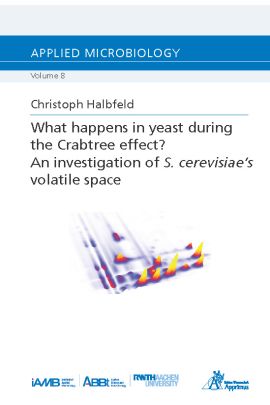In this thesis a metabolic model of S. cerevisiae was enhanced with the biochemistry of volatile metabolites that have been found by a literature investigation. Not only the volatile metabolites in question have been added, but also substances and reactions that connect them to metabolites already present in the model. In total, 225 metabolites and 219 reactions were added to the model. Furthermore, 12 metabolic reactions could be verified by physiological and enzyme assays of knockout mutants.
Additionally, volatile metabolite dynamics during the induction of the Crabtree effect in a fully respiratory growing continuous culture of S. cerevisiae were explored with real-time analyses of the fermentation off-gas. Secondary electrospray ionization-Orbitrap-mass spectrometry was used for this endeavor. In these measurements, I detected about 2,500 signals of which 16 showed a response to the perturbation of the metabolic state prior to the detection of ethanol.
Furthermore, the possibility of online volatile metabolite monitoring due to multi capillary column–ion mobility spectrometry (MCC-IMS) analysis of yeast fermentation off-gas was established. The MCC-IMS used was developed for the detection of volatiles in human breath, and several technical adaptations were applied to allow robust detection of volatiles in the headspace of yeast fermentations.
The MCC-IMS in its optimized configuration was applied to monitor volatile metabolite changes of a laboratory and an industrial yeast strain during the Crabtree effect. In addition, metabolic differences in this setting were examined on transcriptional level using a cDNA microarray. The metabolic shift could be observed in the volatile space of both strains and in all tested conditions. The transcriptome showed differences in the leucine and isoleucine pathways, as well as in genes related to the TCA cycle and the respiratory pathways. Interestingly, the expression data indicated that the industrial strain upregulated its respiration during the shift, while it was downregulated in the laboratory strain.
Lastly, possible applications for the knowledge gained and methods developed in this work are discussed. This thesis provides a blueprint for studies of the volatile space in other organisms. For example, the knowledge gained about the changes in the volatilome during metabolic transitions could be used to online determine and potentially control the metabolic state of a yeast.
| Autor | Halbfeld, Christoph |
|---|---|
| Lieferzeit | 3-4 Tage |
| Gewicht | 0.269 kg |
| Erscheinungsdatum | 14.06.2018 |
Applied Microbiology
What happens in yeast during the Crabtree effect? An investigation of S. cerevisiae's volatile space
Kurzbeschreibung
Saccharomyces cerevisiae is one of the best investigated organisms. However, its volatile space has so far only found little attention in yeast literature. In this thesis the yeast metabolic model has been updated by the volatile space, also the on-line methods SESI-Orbitrap and MCC-IMS have been used to investigate the off-gas of yeast fermentations. In addition, a cDNA microarray has been performed on fermentations in minimal- and industrial molasses medium.

